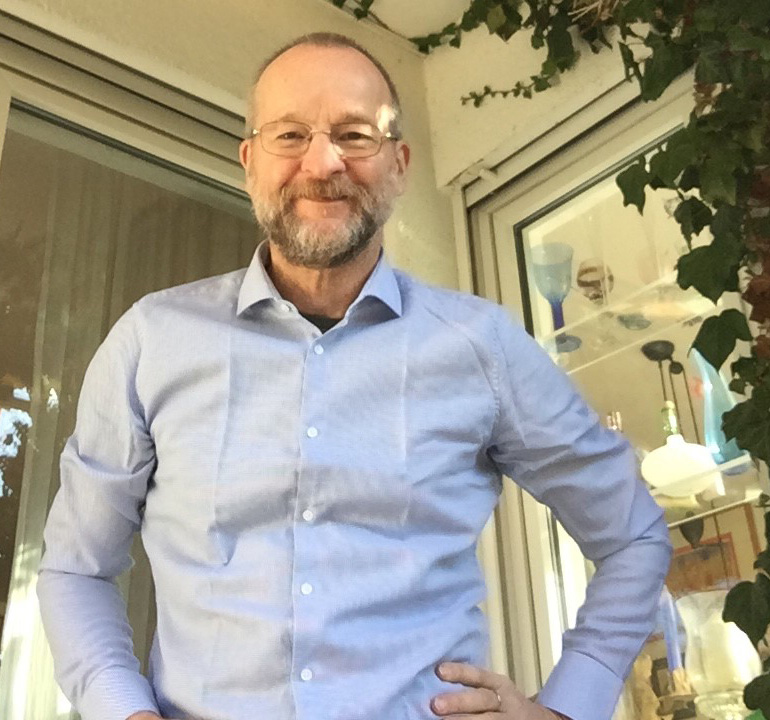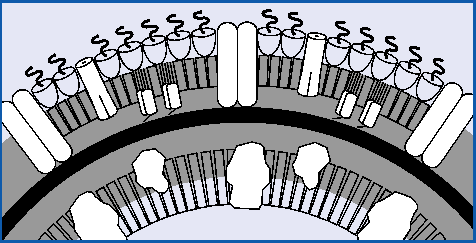What is an endotoxin and where does it come from?
It is released by gram-negative bacteria. Bacteria can be divided into two groups, based on their reaction to a staining test devised by a Danish doctor, Hans Christian Gram. This staining technique differentiates bacteria because of their different outer layers, and those giving a negative reaction are termed gram-negative. The outer layer of these gram-negative bacteria is made up of endotoxin and protein. Gram-positive bacteria do not produce endotoxin.
The endotoxin is shed by the bacterial cell during normal cell growth and division and large amounts of it are liberated when the cell dies and bursts (undergoes lysis). This lysis can be rapidly induced by exposing the bacteria to some types of antibiotic (1), physical or thermal stress.
Endotoxin is a large chemical structure consisting of fat (lipid A) and carbohydrate (polysaccharide), hence its other name lipopolysaccharide or LPS. The lipid A component carries a negative charge. Endotoxin is shed by the cell in large particles which have a high density of negative charges on their surface.
How does endotoxin get into the body?
One way is from the large number of gram-negative bacteria in the gut (2). In some cases, the lining of the gut breaks down or becomes leaky and these bacteria and/or their endotoxin can then pass into the bloodstream. This bacterial translocation is believed to be one of the causes of septic shock in critically ill patients. This route could be called endogenous endotoxin.
Another way is from an infection, such as an abscess or a wound infection, or bacterial infection of a catheter.
The third way is from an external source, such as contaminated equipment or fluids. This could be called exogenous endotoxin. There have been many reports of gram-negative bacterial contamination of intravenous infusion fluids leading to septicaemia (3-13). Fluids and equipment used in IV therapy (14), cardiopulmonary bypass (15-17) and dialysis (18-22) have all been found in the past to be the cause of endotoxic shock. Water can be harmful when it is used for flushing of critical parts of the patient body (e.g., lung (23), wounds, or mucous membranes).
What happens if endotoxin gets into the body?
Endotoxin are a type of pyrogen, which means that they can cause fever when they come into contact with mucous membranes and enter the blood in humans. They also activate a number of signaling pathways of immunocompetent cells that can lead to either inflammation or programmed cell death (apoptosis) of these cells. They are biologically effective even in the lowest concentrations.
How is endotoxin measured?
Currently, the most sensitive method for measuring endotoxin comes from a chemical isolated from horseshoe crabs. This is called the limulus amebocyte lysate test, or LAL test. This is a common way to test for endotoxin in water.
The monocyte activation test (MAT) is an in vitro test based on the human fever reaction with human blood cells (monocytes). The MAT not only records endotoxic pyrogens, but also non-endotoxin pyrogens (not possible in the LAL) and is just as easy to carry out as the LAL test.
How does endotoxin get into the water?
Domestic water installations are regularly contaminated with gram-negative bacteria. The drinking water can therefore contain high concentrations of endotoxin (up to 4 ng/L) (24). It is important to also consider that the use of extremely high temperatures, such as for sterilization, can aid in the creation of large quantities of endotoxin.
Where do you need to monitor and control endotoxin in the water?
It is extremely important to monitor and control for endotoxin in water that is to be used for dialysis or in the reprocessing of equipment that can be used for surgeries, invasive procedures, and other use in the body.
Many countries have regulations, guidelines, and standards in place to set a limit for endotoxin found in the water for specific procedures and equipment.
How do you control endotoxin in the water?
In addition to monitoring endotoxin levels, certain types of filters can help reduce endotoxin in the water. In general, these filters remove endotoxin by either using filtration media with a positive charge or by using media with a very small pore size.
It may also be important to consider the necessity of heat-generating processes when endotoxin is of concern. If high temperatures can be reduced, it will likely simplify monitoring and controlling for endotoxin.
References
- Horn DL, Opal SM, Lomastro E. Antibiotics, cytokines, and endotoxin: a complex and evolving relationship in gram-negative sepsis. Scand J Infect Dis Suppl. 1996;101:9-13.
- Baue AE. The role of the gut in the development of multiple organ dysfunction in cardiothoracic patients. Ann Thorac Surg. 1993;55(4):822-829. doi:10.1016/0003-4975(93)90098-3.
- Leprat R, Michel-Briand Y, Thouverez M, Rozenbaum A, Arlet G, et al. Septicémies à Pseudomonas aeruginosa en relation avec une perfusion médicamenteuse [Pseudomonas aeruginosa septicemia in relation to drug perfusion].Presse Med. 1989;18(31):1524.
- Twum-Danso K, Dawodu AH, al-Fadel Saleh M, Makiling LS. An outbreak of Klebsiella pneumoniae bacteraemia in five children on intravenous therapy. J Hosp Infect. 1989;14(3):271-274. doi:10.1016/0195-6701(89)90049-2.
- Ng PC, Herrington RA, Beane CA, Ghoneim AT, Dear PR. An outbreak of acintobacter septicaemia in a neonatal intensive care unit. J Hosp Infect. 1989;14(4):363-368. doi:10.1016/0195-6701(89)90077-7.
- Bin Ibrahim A et al. Hospital infection—towards the year 2000. Proceedings of the 2nd International Conference of the Hospital Infection Society. London, 2-6 Sept 1990. J Hosp Infect. 1991;18 Suppl A:1-546.
- Lacey S, Want SV. Pseudomonas pickettii infections in a paediatric oncology unit. J Hosp Infect. 1991;17(1):45-51. doi:10.1016/0195-6701(91)90076-k.
- Conlu A, Rothman J, Staszewski H, Schoch PE, Domenico P, Quadri SM, et al. Flavimonas oryzihabitans (CDC group Ve-2) bacteraemia associated with Hickman catheters. J Hosp Infect. 1992;20(4):293-299. doi:10.1016/0195-6701(92)90007-9.
- Ezzedine H, Mourad M, Van Ossel C, Logghe C, Squifflet JP, Renault F, et al. An outbreak of Ochrobactrum anthropic bacteraemia in five organ transplant patients. J Hosp Infect. 1994;27(1):35-42. doi:10.1016/0195-6701(94)90066-3.
- Frean JA, Arntzen L, Rosekilly I, Isaäkson. Investigation of contaminated parenteral nutrition fluids associated with an outbreak of Serratia odorifera septicaemia. J Hosp Infect. 1994;27(4):263-273. doi:10.1016/0195-6701(94)90114-7.
- Bernards AT, de Beaufort AJ, Dijkshoorn L, van Boven CP. Outbreak of septicaemia in neonates caused by Acintobacter junii investigated by amplified ribosomal DNA restriction analysis (ARDRAO) and four typing methods. J Hos Infect. 1997;35(2):129-140. doi:10.1016/s0195-6701(97)90101-8.
- Garland SM, Mackay S, Tabrizi S, Jacobs S.Pseudomonas aeruginosa outbreak associated with a contaminated blood-gas analyser in a neonatal intensive card unit. J Hosp Infect. 1996;33(2):145-151. doi:10.1016/s0195-6701(96)90099-7.
- Fernández C, Wilhelmi I, Andradas E, Gaspar C, Gomez J, Romero J, et al. Nosocomial outbreak of Burkholderia pickettii infection due to a manufactured intravenous produce used in three hospitals. Clin Infect Dis. 1996;22(6):1092-1095. doi:10.1093/clinids/22.6.1092.
- Highsmith AK Biomedical applications of the horseshoe crab (Limulidae). Prog Clin Biol Res. 1979;29:465-471.
- Andersen LW, Baek L, Degn H, Lehd J, Krasnik M, Rasmussen JP. Presence of circulating endotoxins during cardiac operations. J Thorac Cardiovasc Surg. 1987;93(1):115-119.
- Kharazmi A, Andersen LW, Baek L, Valerius NH, Laub M, Rasmussen JP. Endotoxemia and enhanced generation of oxygen radicals by neutrophils from patients undergoing cardiopulmonary bypass. J Thorac Cardiovasc Surg. 1989;98(3):381-385.
- Nilsson L, Kulander L, Nystrӧm SO, Eriksson O. Endotoxins in cardiopulmonary bypass. J Thorac Cardiovasc Surg. 1990;100(5):777-780.
- Nisbeth U, Hällgren R, Eriksson O, Danielson BG. Endotoxemia in chronic renal failure. Nephron. 1987;45(2):93-97. doi:10.1159/000184086.
- Bommer J, Ritz E. Water quality--a neglected problem in hemodialysis. Nephron. 1987;46(1):1-6. doi:10.1159/000184285.
- Watzke H, Mayer G, Schwarz HP, Stanek G, Rotter M, Hirschl AM, et al. Bacterial contamination of dialysate in dialysis-associated endotoxaemia. J Hosp Infect. 1989;13(2):109-115. doi:10.1016/0195-6701(89)90016-9.
- Giagrande A et al. Blood Purification 1992;10:269-275.
- Holmes CJ, Kundsin RB, Ausman RK, Walter CW. Potential hazards associated with microbial contamination of in-line filters during intravenous therapy. J Clin Microbiol .1980;12(6):725-731. doi:10.1128/jcm.12.6.725-731.1980.
- Farokhi A, Heedreik D, Smit LAM. Respiratory health effects of exposure to low levels of airborne endotoxic – a systematic review. Environ Health. 2018;17(1):14. Published 2018 Feb 8. doi:10.1186/s12940-018-0360-7.
- BFGA Info 2003.
Author bio
Dr. Andreas Capewell, PhD – Field Applications Specialist for Scientific and Laboratory Services

Dr. Capewell supports globally the application of filtration of fluids and retention of microorganisms and particles in the medical field. He has over 10 years’ experience of working in different German hospitals and a PhD in Chemistry from the University of Hanover, Germany.
Marissa Khoukaz - Business Development Manager— Hospital Water

Marissa is Business Development Manager for Hospital Water at Cytiva and manages the prefiltration portfolio globally. She works with high-risk units to reduce waterborne pathogen risk to patients.
